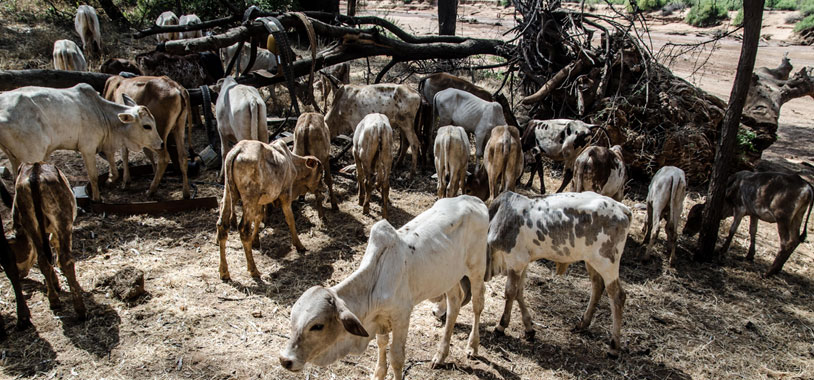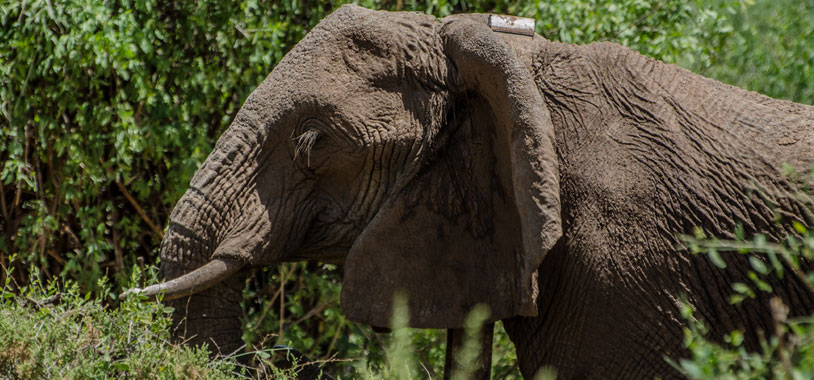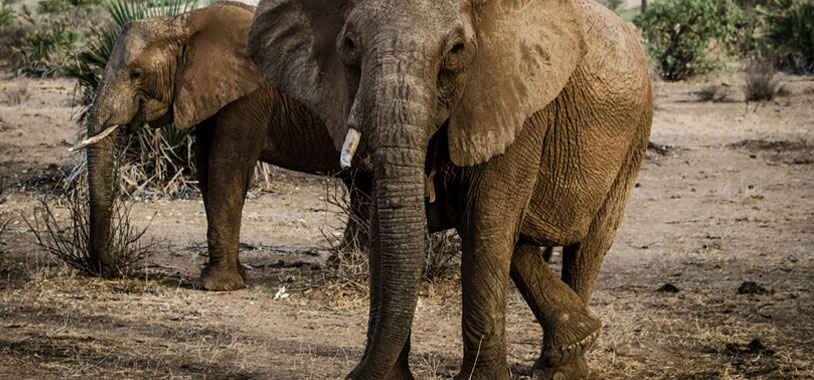Red dusty thermals churning skyward and roasting temperatures have been the mainstays of the last week here in Samburu. As temperatures have climbed steadily throughout much of February, the water that briefly filled the Ewaso just weeks ago has evaporated almost entirely. Farther downriver, to our east, a few natural springs create muddy trickles that sparkle in the sun like memories of greater torrents.
As water has become increasingly scarce, the livestock issue has only grown in its seriousness. Our daily treks to find the dwindling number of elephant families still calling the Samburu-Buffalo Springs areas home aren’t complete unless we see at least two hundred head of cattle gobbling grass. A small herd of unattended calves mowed down the stand of grass just outside of the Save the Elephants office early last week. Cow-mageddon is upon us.
Our regular elephant families fluctuate some – we are almost guaranteed a sighting of the Hardwoods, a rather large family that appears healthy, the American Indians, the Artists, several different pieces of the larger bond group known as the Royals have also made slightly more regular appearances of late. But the combination of lack of water and increasing livestock pressure have driven many families, resident and migrant alike to areas with more food.
One of these areas is a national reserve to our east, called Shaba. With more water in the Ewaso in this reserve and the presence of some greener swamps, elephants seem to be following their rumbling stomachs and parched tongues as a collaring operation that occurred in that region a few weeks ago reported much more elephant activity than we’re seeing in Samburu at the moment. But Shaba isn’t immune to issues surrounding livestock encroachment. The available water has attracted huge herds of cows and rival groups of pastoralists who still engage in a Wild West-type style of cattle raiding, making the reserve very unsafe.
But in a surprise turn of events, it appears that the tide may be shifting.
On February 27, on our way back from our eastern monitoring route, a large group of whitish-gray backs caught our eye. Samburu elephants take on the reddish hue of the mud that rests in the rivers and soil of this reserve and you can tell when they’ve spent a day or two in the reserve – these were not such elephants. Thanks to Shifra’s sharp eyes and her mind seemingly impervious to memory loss, she identified this new collection of elephants as an amalgamation of the Zodiacs, the Clouds, and the Turks – all bearing the tell-tale dusty gray color common of Shaba. Led by the formidable matriarch Taurus, the family was on edge, several gave us wide-eyed stares and ear flares. Taurus was recently re-collared in Shaba with a GSM collar, equipped with a receiver that logs her geographic location every hour and then pings it to our system every time she gets within range of a cell phone tower, which are more common than you’d think here. She’s been out of range for much of the last few weeks, but now that she’s made a pit stop back in Samburu, all of her location data has been uploaded to the Google Earth-based tracking system.
She’s a hiker. Moving with a sense of purpose and perhaps a bit of antsy-ness she’s marched her family in a bee-line from Shaba to Samburu and after we left her and her family in the river, she pinged out farther to the west before arcing around and seeking refuge in a swampy area across the river in Buffalo Springs. Determining the exact mechanism that triggers this mama to trek all over the countryside is still a matter of analysis and perhaps we’ll find out soon.
A quick census of the Zodiacs during our initial count left Shifra a bit worried. A few members of the family aren’t present, or weren’t when we saw them. But without collars on them, it’ll be difficult to determine where they are. And with Taurus appearing to be graced with winged pads that let her traverse great distances in short amounts of time, it’s looking like we may have to wait to see them again to get a read on what happened to these missing females.
The Zodiacs-Turks-Clouds trifecta herd wasn’t the only one to return from Shaba. A family that used to be heavily resident here in Samburu, the Poetics, was seen the day before yesterday. But the reasons for their return may not be entirely food or water related – it could be them seeking safety. Their matriarch, a one-tusked female in her late 30s named Wendy and a male born in 2006 were both sporting bullet wounds – a reminder that elephants are in fact still under threat. Wendy’s wound lays just along her pad on her right hind foot while her grandson was shot at least once in his upper shoulder, the blood still visible in dried, dark streaks. Both individuals are favoring their injured limbs, but the young boy seems to be in much more pain. The inaccuracy of their wounds suggests that the herd was sprayed with bullets – plausibly the result of a herder trying to scare them away. However, a poacher with a terrible shot could of course also be a culprit. Wendy has been shot at least once before, after all.
But conjecture about the origin of the wounds isn’t helpful. We ran across them again on an evening survey on March 1, after they managed to disappear for a day. Despite being collared under a year ago, her GSM collar stopped working and we hope to re-equip her in the next day or two – provided we can get access to a vet and keep an eye on her to make sure she doesn’t lead her family out of the reserve. With her down, and the vet present, we’ll hopefully be able to treat her and her grandson before their wounds turn septic. Tensions are running high as the clock starts ticking for the dominoes to fall into place to make this operation happen. For the sake of Wendy and her lineage, I hope they tip just in time.




